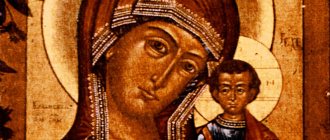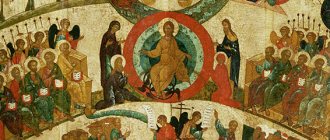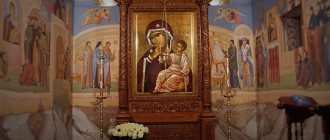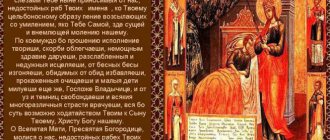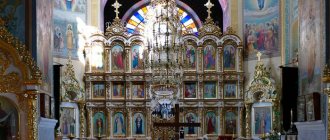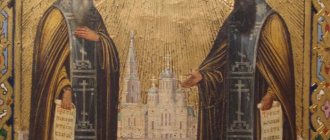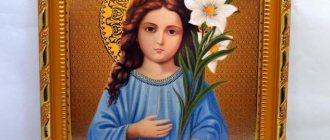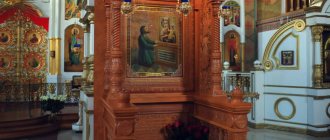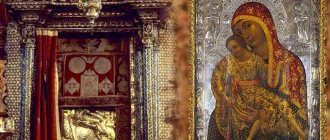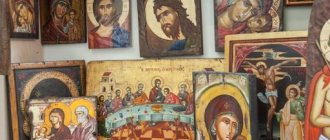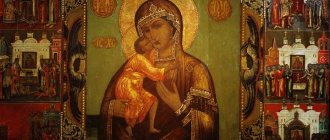Varieties of Orthodox icons of the Blessed Virgin Mary with names
In the Russian Orthodox calendar there are about two hundred and sixty venerated icons of the Mother of God. The total number of images of the Mother of God is about eight hundred and sixty icons. Let's look at some of the most famous types of images of the Blessed Virgin Mary.
Kazanskaya
this is one of the most common images of the Virgin Mary: the Virgin Mary herself is depicted with a bust at shoulder level, and the Baby Jesus sits on her arm. Their gaze is turned to those praying. It is customary to bless newlyweds for marriage with this icon; hanging near children's cribs.
Inexhaustible Chalice
A miraculous icon, known since the end of the 19th century. According to legend, this image of the Mother of God appeared to the world as a source of help for people suffering from alcoholism. The image depicts the Mother of God herself, and in front of her stands the Child Jesus Christ in a chalice. The original image was lost in the 1920s.
Feodorovskaya
According to legend, one of the first images of the Evangelist Luke. At the site of the apparition, a miraculous monastery was built in the name of the Savior. The icon depicts the Mother of God pressing her cheek to a child hugging her. On the reverse is an image of the holy martyr Paraskeva Pyatnitsa, patroness of weddings.
Sovereign
The image was first discovered during the February and October revolutions in the basement of the Church of the Ascension of the Lord in the village of Kolomenskoye. This is the main sanctuary of Russian monarchists. According to legend, it is considered a symbol of the fact that the fall of the monarchy was sent to the Russian people as punishment for their sins.
Vladimirskaya
According to legend, it was written by Luke during the life of the Virgin Mary on the table during which Jesus Christ dined with the Virgin Mary and the righteous Joseph. The image remained in Palestine until the middle of the 5th century AD, after which the icon was transported to Constantinople. In the 12th century, a copy was sent to Kyiv.
Tikhvinskaya
Another of the first icons attributed to Luke. It remained in Constantinople until the 14th century, when it disappeared. The chronicles say that at the same time he appeared to fishermen on Lake Ladoga near the city of Tikhvin.
Three-handed
This is an image of the Virgin Mary and Child on her right hand. Below the right hand is a human hand. Traditionally it is believed that the third hand belongs to the Virgin Mary.
Unexpected joy
Written under the influence of Dmitry Rostovsky's story about a miraculous vision of a sinner, which tells about a man who prayed to the icon of the Mother of God and then committed a crime. One day he saw the image move. Christ's wounds were opened and blood was shed. The sinner asked him for mercy. The image repeats the plot of the story: in the lower left corner a man is placed in prayer in front of the image of the Virgin Mary with a baby, in torn clothes and with sores.
Blissful womb
The icon depicts the Mother of God sitting on a pillow with a baby in her arms, hugging her chest. The image has the characteristic features of Italian painting, and is therefore considered a copy of the Italian original.
Annunciation
Dedicated to the Feast of the Annunciation. The image includes the Archangel Gabriel and the Blessed Virgin Mary herself. It describes the event recorded in the Gospel of Luke when the Lord sent the archangel Gabriel with the good news that Mary was destined to become the mother of the Savior of mankind.
blessed sky
The main meaning of the image is the glorification of the Mother of God as the Queen of Heaven. Its prototype was the icon “Woman Clothed in the Sun.” The image of the Wife is usually interpreted as a symbol of the Christian church.
Joy to all who mourn
Here the Virgin Mary is depicted surrounded by people in need and angels who perform good deeds for her. This is a symbol of the intercession of all the poor, hungry and sick.
Upbringing
Here the Virgin Mary is depicted with the Child Jesus on her left arm. The right hand of Jesus extends over the face of the Virgin Mary. The original image was in the Kazan Cathedral until 1917, after which it was lost due to the destruction of the temple.
Life-giving spring
According to legend, the appearance of the icon occurred in the 5th century in Constantinople, in a grove near the Golden Gate. In this forest there was a sacred spring, which has long been glorified by miracles.
Deliverer
The icon gained its fame in the 17th century, when one of the Greek provinces, thanks to prayers, got rid of a locust invasion. The miracles emanating from this image attracted many pilgrims, who burdened the guardian of the sanctuary, Martinian.
Alexander III carried the image of the Redeemer on the train when he was traveling with his family from vacation. The train crashed, but the royal family was miraculously saved.
Key of Understanding
Here the Virgin Mary is depicted in full growth, and at the bottom of the image is a key. It is a symbol of reason and knowledge. Prayers are performed in front of the picture before children begin their education, and also if children have mental retardation.
Mammal
The Virgin Mary feeds the infant Christ. Sometimes depicted wearing a crown and with angels. They immediately pray for the children's health and ask for more breast milk.
Everlasting color
Virgin Mary with a child in her right hand and a white lily in her left. It symbolizes the unchanging light of the virginity of the Mother of God.
Otrada
One of the first images considered miraculous. The origin is connected with the miraculous rescue of the son of Theodosius the Great, Arkady, who fell into the water from a sailing ship near the monastery located on Mount Athos.
Childbirth assistant
The icon is traditionally prayed to by women asking for the birth of children and the well-being of childbirth. Located in the Church of the Transfiguration of the Lord on Bolvanovka and in the Conception Stavropegial Convent.
Self-written
Icon from Mount Athos parody of John the Baptist. It received this name because, according to legend, the artist who painted it was unable to successfully complete the work on it and sent it back in the morning, allowing himself to pray. In the morning I found that the image was completely ready.
Quick to Hear
Prayers to this icon help in unclear situations and bewilderment. A cheerful woman is a symbol of help in a difficult situation, when you urgently need to resolve issues or solve some problems.
Quench my sorrows
The Virgin Mary holds the infant Christ in her right hand. In his hands is a parchment with a message to the people. The image is a symbol of liberation from illness and mental suffering.
Healer
it is known for miraculous cases of healing of people who prayed in front of this icon. This is a symbol of healing from illness.
Semistrelnaya
Here the Virgin Mary is depicted, pierced by seven arrows. Similar to the “Softening Evil Hearts” icon, only the arrows are on either side of the Virgin Mary. There have been many reports of miracles performed in this way, such as healing from mental illness and suffering.
All-Tsaritsa
This image is the most powerful for prayers for salvation from incurable diseases, including oncology. In addition, the icon protects against evil witchcraft. Prayers before the queen help get rid of harmful addictions.
Worthy to eat
By turning to this icon, he can forgive the most serious sins, provided that the prayer repents of his guilt. Free your mind and soul from sinful beliefs.
The Omen
Image of the Virgin Mary seated, raising her hands in prayer. On his chest is the image of the baby Jesus Christ against the background of a round shield. This is one of the oldest icons of Orthodox Rus'.
Iverskaya
A symbol of the fact that the Virgin Mary took the entire human race under her intercession.
Recovery of the dead
An icon dedicated to parents who pray for their children, a symbol of consolation in the pain of parents. Before her, it is customary to pray for the health of loved ones, from whom long separation is inevitable.
WHAT ARE THE BEST ORTHODOX FEMALE ICONS
no comments
From time immemorial, female icons of saints were considered the most powerful, designed to protect the fair half of humanity. Every Christian woman always has a female personal icon in her home iconostasis, which occupies a special place among all others. The miraculous icon of the Iveron Mother of God is considered the most widely known female icon in the world of Orthodoxy and among representatives of other faiths. The icon of the Iveron Mother of God has a long history and it began in the 9th century in the house of a Christian woman. By imperial order, the iconoclasts were to destroy all icons. When the turn came to this icon, one of the iconoclasts pierced it and blood flowed from that place. To save the female icon, the woman took it to the sea and the icon floated, standing on the water. One Athonite monk found it and placed it in the temple, and after a night vision it was moved under the monastery gates so that the icon could protect the servants of God. This female miraculous icon is also called the Goalkeeper.
The meaning of the female miraculous icon - the keeper of the hearth
This strong Orthodox female icon is very popular among devout women, as it is designed to protect the hearth and home. In addition, the icon provides assistance to all sinners who have repented of their sins. She gives them strength and directs them to the path of repentance and truth. In addition, loved ones and relatives of those who have not yet repented can ask for mercy and forgiveness from the icon for them.
Like any other female miraculous icon, it grants healing from physical and mental ailments. In addition, the Iveron Icon of the Mother of God helps the hostess protect and preserve her earthly inheritance and home.
It is not for nothing that this female icon of the saint has another name - the Goalkeeper, because she is able to warn and prevent danger that could threaten the house and all its inhabitants. For example, an icon can save you from fire, flood or thieves.
Where can I buy a female Orthodox icon?
The Christian icon of the Iveron Mother of God can be purchased both in specialized stores and on online portals. In addition, you can order a female icon from an icon painting workshop. One of the most acceptable ways to get such a female saint icon is to embroider it yourself. To do this, you only need a desire, everything else is quite simple: choose the size of the female icon, color scheme and frame that suits you.
Four types of saint images
There are four main types of images of the Virgin Mary.
The first type of iconography is Senyo or Oranta. The Mother of God is depicted here in prayer, raising her hands to the sky, on her chest there is a beautiful medallion with the image of Christ.
The second type is Hodegetria. The Virgin Mary is in the middle, and the baby Jesus sits on one of her arms. Usually the Mother of God is depicted from the waist up, but there are icons that differ in the composition of the shoulders. This type includes most of the old images attributed to the Evangelist Luke.
The third type is attachment. The Virgin Mary bows her head to the child and hugs him by the neck.
The fourth type is the akathist. It includes icons that were not included in the first three types, including rare examples that do not depict the baby Jesus.
How to Pray to Pregnant Women
Pregnant women turn to the icon of the Mother of God “Unidle . This is a slightly unusual image, in which the Mother of God is depicted without a baby in her arms, but with a child in her womb.
It is customary to read the following prayer:
By the way, this icon did not appear just like that. This is an illustration of a scene from the Gospel in which Saint Joseph learned that his betrothed Mary was carrying a child under her heart. He decided to let her go. With one hand the Virgin in the icon wipes away her tears, and with the other she swears that she did not know the man and did not cheat on her betrothed.
As we know, after this conversation, righteous Joseph, who loved Mary very much, did not abandon her, and subsequently raised her Son as his own.
Some non-idle women are afraid to go to church, because you have to stand there a lot, sometimes there is a crush, and some superstitious ladies are even afraid that they will be jinxed (although superstition is not befitting of the Orthodox). In fact, even the Apostle Paul encouraged pregnant women to visit the House of God more often. He said that regularly visiting a place of prayer is very beneficial for young mothers .
Don't be afraid of any evil eye. But concerns about crowds at large services are justifiable. Therefore, you can attend church on non-holiday days, but sit during the service - you should not overwork yourself even for the sake of prayer, so as not to harm the baby.
Is prayer necessary during childbirth?
Even priests do not have a clear answer to this question.
Some say it's not needed. Others advise praying not to the woman herself, but to her closest relatives. Still others claim that in the hour of the most difficult “work”, prayer will support and strengthen.
In any case, you can take a small laminated (its surface can even be wiped with an antiseptic) “Childbirth Assistant” icon to the delivery room . She is considered the strongest at such moments. In addition, on the back of the icon there will be a prayer to this icon.
How to pray for pregnant women
There are special prayers for non-idle women (relatives, friends, neighbors). They are read both in church in front of icons and at home.
Some people pray for both the woman’s health and her child’s health. This is wrong - you need to turn to God only for the mother (she is baptized, but the baby who has not yet been born is not yet).
You can also leave notes . The word “pregnant”, “fruit-bearing” or “non-idle” should be added to her name (ecclesiastical, not secular).
If you are very worried about the health of such a woman, or she is about to give birth, you can order a sorokoust for her health. Thanks to this, priests will pray for her health in the temple for a whole month. Sorokoust is ordered from a candle shop.
The history of the origin of the first icons
The first images of the miraculous face of the Virgin Mary are attributed to the authorship of the Evangelist Luke. He is considered one of the first icon painters in the Orthodox and Catholic traditions. According to legend, he was sent to earth as part of the seventy apostles of Christ during his lifetime. He came from the Greeks and was one of the authors of the New Testament. He painted the first images of the Virgin Mary and the apostles Peter and Paul.
Elements of iconography
In most images, the Virgin Mary is depicted with a baby - Jesus Christ, sitting to her right, less often - on her left hand. The gaze is directed at the person praying, and, depending on the specific appearance, he may appear calm or tired of human sins.
The Virgin Mary is traditionally worn with maforia, the clothing worn by married women. Stars on clothes mean purity and are a symbol of the Holy Trinity. There is a halo above the head of the Virgin Mary.
The iconographic images contain the inscriptions: “MR OU” and “IC XC”, which respectively mean the names “Our Lady” and “Jesus Christ”. In the Orans version of the icons, Jesus is depicted on a medallion of the Virgin Mary, and the Blessed Virgin herself is depicted standing with her hands raised in prayer.
Prayers
There are as many prayers to the Most Holy Theotokos as there are varieties of her images. It is generally accepted that it does not matter which icon you pray on, since the prayer is not addressed to a specific image, but to the saint depicted on it.
The most important thing is that the prayer is sincere, comes from the heart and carries exclusively noble intentions. Here are some of the commonly used basic prayers.
First
“My queen, resident, my hope, Mother of God, refuge of orphans and patroness of travelers, joy of sorrow, offended patroness! Look at my trouble, look at my pain; Help me as a weak person, guide me as a stranger. You know my offense: resolve it according to Your will. Because I have no other help but You, no other Protector, no good Comforter, only You, Mother of God: protect me and keep me forever and ever. Amen".
Second
“Virgin Mary, rejoice, blessed Mary, the Lord is with you! You are the most blessed of women. Blessed is the fruit of your womb, for you have given birth to the Savior of our souls.”
An idle woman is...
Less often in Russia they said this about a woman busy with work . The word "idle" was also used at that time. It meant “empty,” “idle,” “not occupied with anything.” You can still hear the expression “idly staggering,” that is, “one who walks around without doing anything.” They can also say “an idle word” - these will be words not supported by experience.
But more often (and this is the interpretation that has survived to this day, mainly in church terminology) this is what they said about a woman who carries a child under her heart .
In the Bible, the main task of women was the birth of children (“a woman... is saved through childbearing”). And the more children a believer has, the more Orthodoxy she respects. Pregnancy in the Christian faith is considered the main job of the fairer sex. Hence the non-idleness - after all, carrying a baby under her heart, a woman does not “sit idle.”
Getting rid of idleness
It is easy to guess that life in a marriage, but in a childless status, is called idleness by faith.
Many modern ladies, after being registered at the registry office and even getting married, prefer not to have children for some time, living for themselves. The Orthodox Church considers such women to be sinners and lazy, calling them to repent of this idleness, fast as a sign of humility and pray.
But there are other cases: a couple lives in love and prays for children, but the years go by and still no children. Such women go to the temple and read prayers for deliverance from idleness, that is, simply put, asking the Lord and the saints for pregnancy .
Such an idle woman can:
- confess;
- take communion;
- receive the priest's blessing;
- pray in front of the icons of the Mother of God, Xenia of Petersburg, Mother Matrona.
You can address the images in your own words, simply pouring out your soul to them. There are also special prayers for pregnancy. For example:
Less often, the church calls a woman idle, regardless of her married status, who devotes all her free time to entertainment instead of doing godly deeds (prayers, helping the poor).
